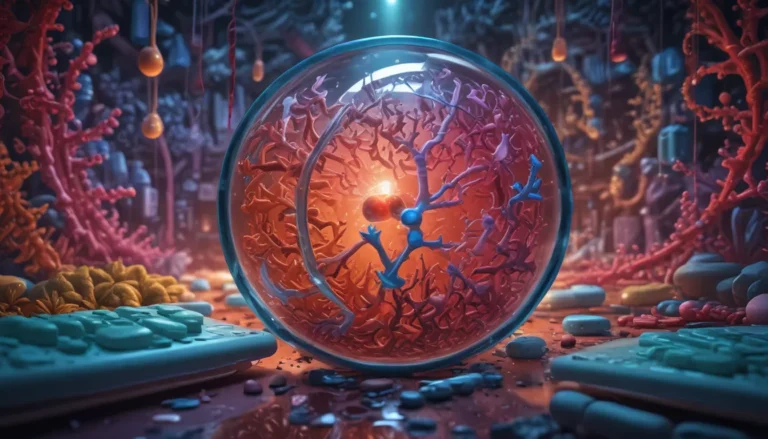A Note About Images: The images used in our articles are for illustration purposes only and may not exactly match the content. They are meant to engage readers, but the text should be relied upon for accurate information.
Are you ready to embark on a fascinating journey into the intricate world of the nucleus? As one of the most essential components of a cell, the nucleus serves as a command center, orchestrating a myriad of cellular activities. In this article, we will delve into the enigmatic realm of the nucleus and uncover ten intriguing facts that will astonish you with the complexity and wonder of cellular life. So, fasten your seatbelt and get ready to explore the nucleus in all its mysterious glory!
Understanding the Nucleus: The Brain of the Cell
Picture the nucleus as the brain of a cell, overseeing all its activities and harboring the genetic blueprint for life. Acting as a command center, the nucleus regulates gene expression, DNA replication, and cell division, playing a vital role in ensuring the cell’s functionality.
The Protective Nuclear Envelope
Encased within the nucleus is the nuclear envelope, a double membrane that safeguards the genetic material inside. This protective barrier contains nuclear pores that facilitate the movement of molecules in and out of the nucleus, ensuring a regulated exchange of essential components.
Chromosomes: The Building Blocks of Life
Inside the nucleus, DNA molecules are intricately organized into chromosomes, iconic structures containing genetic information crucial for the development and functioning of all living organisms. These thread-like structures hold the key to life’s complexities and variations.
Nucleoli: The Genesis of Protein Synthesis
Embedded within the nucleus are nucleoli, responsible for fabricating ribosomes, the cell’s protein synthesis machinery. These small, spherical organelles play a vital role in protein production and cellular function, showcasing the intricate processes within the nucleus.
Nucleoplasm: A Symphony of Chemicals
The nucleoplasm, a gel-like substance filling the nuclear region, is composed of water, ions, proteins, and enzymes that facilitate DNA replication, transcription, and repair. This complex mixture forms the backdrop for essential cellular processes within the nucleus.
Unraveling the Secrets of Nuclear DNA
The nucleus houses the bulk of a cell’s genetic material in the form of DNA, holding the instructions for building and maintaining an organism’s traits and characteristics. This intricate molecule plays a central role in shaping an organism’s identity and functions.
The Structural Backbone: Nuclear Matrix
Known as the nucleoskeleton, the nuclear matrix provides structural support to the nucleus, organizing chromosomes, coordinating nuclear processes, and maintaining the nucleus’s overall shape and integrity. It acts as the architectural scaffold that keeps the nucleus functioning smoothly.
Maintaining Stability: The Role of Nuclear Lamina
Comprising intermediate filaments, the nuclear lamina is located on the inner surface of the nuclear envelope, providing mechanical support and stability to the nucleus. This network of filaments contributes to maintaining the integrity of the nucleus and ensuring its proper functioning.
The Gatekeeper: Nuclear Transport
Nuclear pores in the nuclear envelope act as gatekeepers, regulating the movement of molecules between the nucleus and the cytoplasm. This intricate control mechanism ensures that only essential molecules, such as RNA and proteins, enter or exit the nucleus, maintaining cellular stability.
The Dynamic Nature of the Nucleus
Dynamic and ever-changing, the nucleus responds to the cell’s needs by undergoing constant remodeling, compartmentalization, and reorganization. This adaptability allows the nucleus to accommodate various cellular processes and environmental cues, reflecting its dynamic nature within the cell.
In conclusion, the nucleus stands as a testament to the complexities and wonders of cellular life, offering scientists a continuous source of fascination and exploration. These ten enigmatic facts shed light on the nucleus’s intricate structures and functions, providing a glimpse into the captivating world within.
FAQs: Unveiling the Mysteries of the Nucleus
Q: What is the nucleus?
A: The nucleus is a membrane-bound organelle found in eukaryotic cells, serving as the control center and housing the cell’s genetic material.
Q: What is the function of the nucleus?
A: The nucleus plays various roles, including storing and protecting DNA, controlling gene expression, and synthesizing RNA, essential for cellular processes.
Q: How does the nucleus store genetic information?
A: Genetic information is stored in the form of DNA molecules, organized into chromosomes within the nucleus, dictating an organism’s traits and characteristics.
Q: Can abnormalities in the nucleus lead to diseases?
A: Yes, abnormalities in the nucleus, such as mutations or chromosomal rearrangements, can contribute to genetic disorders and certain types of cancer, emphasizing the nucleus’s critical role in cellular health.
Q: Can the nucleus regenerate?
A: Under specific conditions, such as cellular damage, the nucleus can regenerate through the replication of DNA and the activation of specific genes, highlighting its adaptability and resilience.
As you continue your exploration of the nucleus, delve deeper into the captivating world of subatomic particles and cellular structures, unraveling the mysteries of alpha decay, the strong nuclear force, and prokaryotic cells. Each topic offers a unique perspective on the intricate workings of our universe at the microscopic level, enriching your understanding and appreciation of the complexities that surround us.
Embrace the Journey of Discovery
Our commitment to delivering trustworthy and engaging content drives us to provide valuable insights and information to our readers. Each fact on our site is contributed by users like you, ensuring a diverse range of perspectives and knowledge. With meticulous editorial review processes, we guarantee the accuracy and reliability of the content we share, inviting you to explore and learn with confidence. Trust in our dedication to quality and authenticity as you embark on a scientific journey of discovery and enlightenment.






